Basis of Classification | Term 2 Unit 5 | 7th Science - Questions Answers | 7th Science : Term 2 Unit 5 : Basis of Classification
Chapter: 7th Science : Term 2 Unit 5 : Basis of Classification
Questions Answers
Evaluation
I. Choose
the correct answer.
1.
The following characteristics are essential for classification.
a. Similarities
b. Differences
c. Both of them
d. None of
them
Answer: (e) Both of them
2. Approximately
____________ species of living organisms found in the earth.
a. 8.7 million
b. 8.6 million
c. 8.5 million
d. 8.8 million
Answer: (a) 8.7 million
3. The
largest division of the living world is __________
a. Order
b. Kingdom
c. Phylum
d. Family
Answer: (b) Kingdom
4. Who
proposed the five kingdom of classification?
a. Aristotle
b. Linnaeus
c. Whittakar
d. Plato
Answer: (c) Whittakar
5. The
binomial name of pigeon is _________
a. Homo sapiens
b. Rattus rattus
c. Mangifera indica
d. Columbo livia
Answer: (d) Columbo
livia
II. Fill
in the blanks.
1. Gaspard Bauhin in 1623, introduced the
binomial nomenclature.
2. Species is the basic unit of classification.
3. Fungi are non- green and non-photosynthetic
in nature.
4. The binomial name of onion is
5. Carolus
Linnaeus is known as the Father of
III. True (or) False. If false write the correct answer.
1. Classification
helps to know the origin and evolution of an organism.
2. Fishes are aquatic vertebrates.
3. In the year 1979, Five kingdom classification
was proposed.
In the year 1969, Five
kingdom classification was proposed.
4. True nucleus is seen in prokaryotic cell.
True nucleus is seen in
Eukaryotic cell.
5. Animal cells have cell wall.
Animal cells do not have
cell wall Plant cells have cell wall.
IV. Match
the following.
1. Monera
– Moulds
2. Protista – Bacteria
3. Fungi – Neem
4. Plantae –
Butter fly
5. Animalia – Euglena
Answer :
1. Monera - Bacteria
2. Protista - Euglena
3. Fungi - Moulds
4. Plantae - Neem
5. Animalia - Butterfly
V. Assertion
and Reason Questions
1. Assertion:
Binomial name is the universal name and contains two names.
Reason :
It was first introduced by Carolus Linnaeus
a. Assertion is correct, Reasoning is correct
b. Assertion is correct, Reasoning is incorrect
c. Assertion is incorrect Reasoning is correct
d. Assertion and Reasoning are incorrect
Answer: b. Assertion
is correct, Reasoning is incorrect
2. Assertion:
Identification, assortment and grouping are essential for classification
Reason :
These are basic steps of taxonomy
a. Assertion is correct, Reasoning is correct
b. Assertion is correct, Reasoning is incorrect
c. Assertion is incorrect Reasoning is correct
d. Assertion & Reasoning is incorrect
Answer: a. Assertion
is correct, Reasoning is correct
VI. Give
very short answer
1. What
is classification?
The method of arranging the
organisms into groups is called classification. When we classify things we put
them into groups based on their characteristics.
2. List
out the five kingdoms classification
1) Monera
2) Protista
3) Fungi
4) Plantae
5) Animalia
3. Define
– dichotomous key
Dichotomous key is a tool
used to classify organisms based on their similarities and differences.
4. Write
two examples of Monera.
1) Bacteria
2) Blue green algae
5. What
is binomial nomenclature?
Binomial nomenclature is a
universal system of naming organisms. It contains two names. The first name of
binomial is genus name and the second name is species name.
6. Write
the binomial name of a) Human being b) Paddy
a) Human being - Homo sapiens
b) Paddy - Oryza sativa
7. Write
two features of protista
1) It includes unicellular and a few simple multicellular
eukaryotes.
2) The plant-like protists are photosynthetic.
VII. Give short
answer
1. Write
the levels of classification.
The classification of
living things include seven levels. They are 1. kingdom, 2. phylum, 3. classes,
4. order, 5. families, 6. genus and 7. species.
2. Differentiate
plantae and animalia
Planatae (plants) are multicellular eukaryotes that carry out
photosynthesis. Reserve food materials are starch and lipids in the form of oil
or fat. Plant cells have cell wall and specialized functions, such as
photosynthesis, transport of materials and support.
Animalia (animals) are multicellular, eukaryotic and
heterotrophic animals. Cells have no cell wall. Most members of the animal
kingdom can move from place to place.
3. Write
any two merits of Five Kingdom classification.
❖ This system
of classification is more scientific and natural.
❖ This system
of classification clearly indicates the cellular organization, mode of
nutrition, and characters for early evolution of life.
❖ It is the
most accepted system of modern classification as the different groups of organisms
are placed phylogenetically.
❖ It
indicates gradual evolution of complex organisms from simpler one.
VIII. Give
answer in Detail
1. Explain
about five kingdom classification
Kingdom Animalia: Animalia (animals) are multicellular, eukaryotic and heterotrophic
animals. Cells have no cell wall. Most members of the animal kingdom can move
frojn place to place. Eg. Invertebrates like sponges, hydra, flatworms, round
worms, insects, snails, starfishes. Vertebrates like Fish, amphibians,
reptiles, birds, and mammals including human beings belong to the kingdom
Animalia.
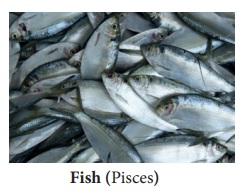
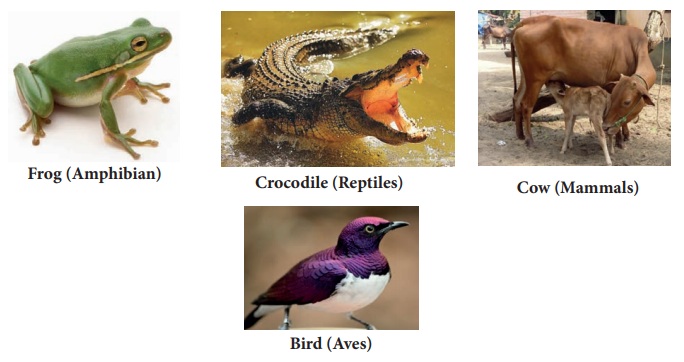
IMPORTANT
CHARACTERISTICS OF FIVE KINGDOMS
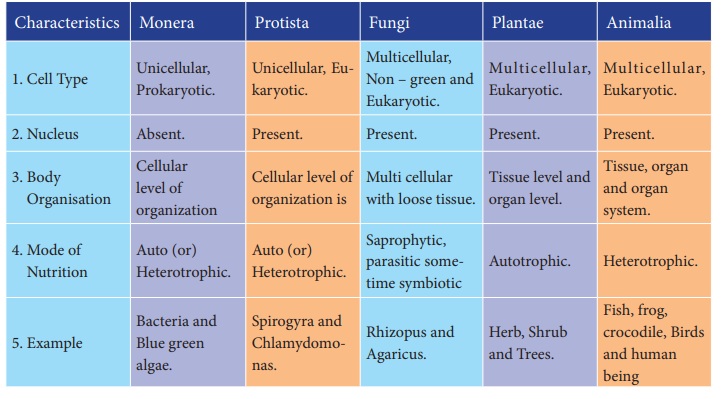
2. Write
short notes on – Binomial Nomenclature.
Gaspard Bauhin in 1623, introduced naming of organisms with two
names which is known as Binomial nomenclature, and it was implemented by
Carolus Linnaeas in 1753. He is known as ‘Father of Modern Taxonomy’.
Binomial nomenclature is a universal system of naming organisms.
As per this system, each organism has two names - the first is the Genus name
and the second is the Species name. Genus name begins with a capital letter and
Species name begins with a small letter.
Example: The nomenclature for onion is Allium sativum. Genus name is Allium, species name is sativum.
3. Give
an account on the classification of invertebrates with few general features and
examples.
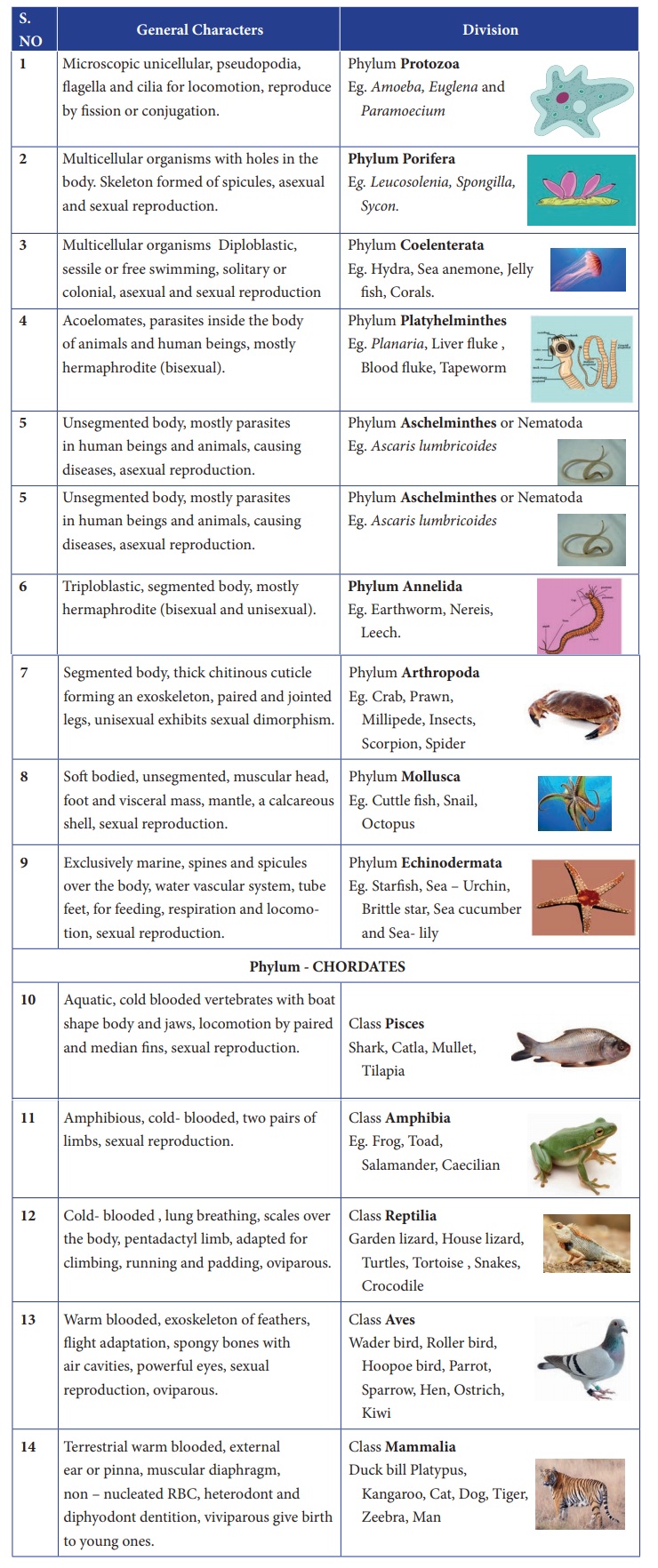
General Characters
1. Microscopic unicellular, pseudopodia, flagella and cilia for
locomotion, reproduce by fission or conjugation.
Division: Phylum
Protozoa
Eg. Amoeba, Euglena and Paramoecium
2. Multicellular organisms with holes in the body. Skeleton
formed of spicules, asexual and sexual reproduction.
Division: Phylum
Porifera
Eg. Leucosolenia,
Spongilla, Sycon.
3. Multicellular organisms Diploblastic, sessile or free
swimming, solitary or colonial, asexual and sexual reproduction
Division: Phylum
Coelenterata
Eg. Hydra, Sea anemone, Jelly fish, Corals.
4. Acoelomates, parasites inside the body of animals and human
beings, mostly hermaphrodite (bisexual).
Division: Phylum
Platyhelminthes
Eg. Planaria, Liver
fluke, Blood fluke, Tapeworm
5. Unsegmented body, mostly parasites in human beings and
animals, causing diseases, asexual reproduction.
Division: Phylum
Aschelminthes or Nematoda
Eg. Ascaris lumbricoides
6. Triploblastic, segmented body, mostly hermaphrodite,
(bisexual and unisexual)
Phylum Annelida
Eg. Earthworm, Nereis, Leech.
7. Segmented body, thick chitinous cuticle forming an
exoskeleton, paired and jointed legs, unisexual exhibits sexual dimorphism
Division: Phylum
Arthropoda
Eg. Crab, Prawn, Millipede, Insects, Scorpion, and Spider.
8. Soft bodied, unsegmented, muscular head, foot and visceral
mass, mantle, a calcareous shell, sexual reproduction.
Division: Phylum
Mollusca
Eg. Cuttle Fish, Snail, Octopus.
9. Exclusively marine, spines and spicules over the body, water
vascular system, tube feet, for feeding, respiration and locomotion, sexual
reproduction
Division: Phylum
Echinodermata
Eg. Starfish, Sea - Urchin, Brittle star, Sea cucumber and Sea-lily
IX.HOTS
Which
kingdom has saprophytic, parasitic and symbiotic nutrition. Why?
'Fungi' has the mode of nutrition - saprophytic, parasitic and
sometimes symbiodic.
Parasites grow upon living hosts, e.g : powdery mildews.
Saprophytes live on dead and decayed things, e.g Mucor. Symbiotic association
is between a green plant and a fungus. The plant makes food by photosynthesis.
It supplies the food to the fungus. The fungus in turn supplies the plant with
water and mineral nutrients taken from the soil. e.g Mycorrhiza.
X. See
the Diagram and write the kingdom :
Pictures
of some living organisms are given below. Identify the kingdom to which each of
these belong and write the kingdom name in the blanks provided.
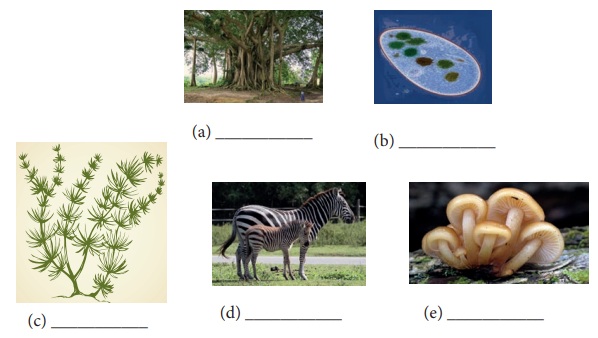
Pictures of some living organisms are given below. Identify the kingdom to which each of these belong and write the kingdom name in the blanks provided.
(a) Plantae (b) Protista
(c) Monera (d) Animalia (e) Fungi
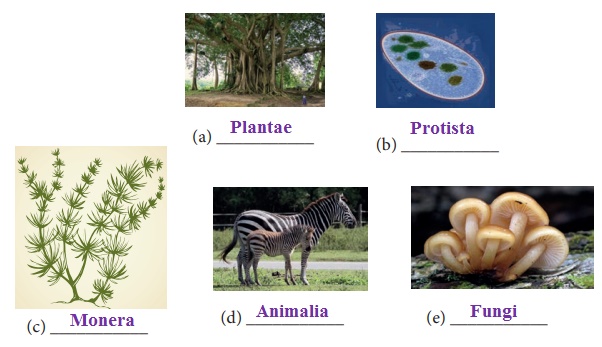
Related Topics